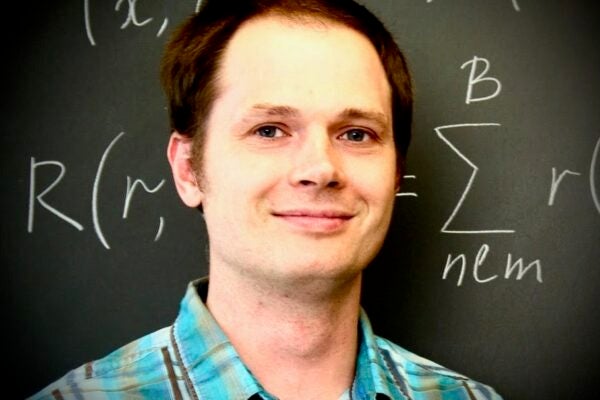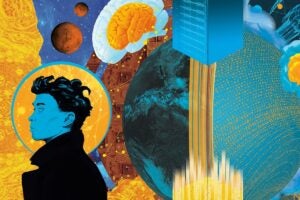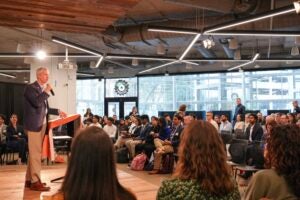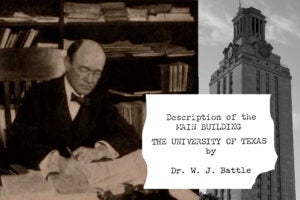Dima Kozakov’s research team is at the forefront of developing a new generation of computational tools that are transforming drug design. His models integrate physics, artificial intelligence and computational biology to help explain the mechanisms of disease at the molecular level.
This fall, UT’s Oden Institute for Computational Engineering and Sciences recruited Kozakov and his team away from Stony Brook University on Long Island, New York. He now holds the W.A. “Tex” Moncrief, Jr. Chair in Computational Life Sciences and Biology with a joint appointment between the Oden Institute and the Department of Molecular Biosciences in the College of Natural Science. It’s the first time these two units have made a joint hire. Kozakov did his undergraduate studies in Moscow, earned a doctorate at Boston University, and taught applied mathematics at Stony Brook University before coming to Austin.
Kozakov recently was awarded a $6 million grant by the Cancer Prevention and Research Institute of Texas, which will be distributed over five years as part of CPRIT’s Recruitment of Established Investigators program. He will help jump-start a new research center at the Oden Institute focused on AI and physics in drug discovery. Kozakov wants to transform the way cancer therapeutics are discovered and designed and hopes to speed up the development of personalized treatments for some of the most difficult-to-treat cancers.
1) What was it like moving your entire team from New York to Texas? And in summer, no less!
It was hectic but exciting, the kind of organized chaos that comes with moving both a lab and a family halfway across the country. There were endless logistics to figure out and personal situations to untangle. I made that trip between New York and Austin several times. One of them turned into a family road trip in a van, which was actually a lot of fun. My son is a big Johnny Cash fan, so a stop at the Johnny Cash Museum in Nashville was a must and definitely the highlight of the journey.
In the end, the goal made it all worth it. The chance to build a new center for AI and physics in drug discovery, something we had been dreaming about for a while, completely outweighed the stress. People warned me about the Texas summer heat, yet when you are focused on building something new, you barely notice it.
The support from the Oden Institute, the Department of Molecular Biosciences, and UT Austin was incredible, and that is what made the whole move possible. My team was just as enthusiastic. Coming from a small college town on Long Island, Austin feels like a big, vibrant upgrade. One person joined a yacht club. Another settled into a high-rise downtown, enjoying the energy of city life. Everyone found their own version of Texas.
2) What are your first impressions of the University, of Austin and of Texas?
My first impression of UT Austin was how welcoming and intellectually stimulating it is. It is an environment that truly encourages ideas to flow, where people are open, collaborative, and things actually get done efficiently. There is a great balance of friendliness and focus that makes it easy to build and create.
My first impression of UT Austin was how welcoming and intellectually stimulating it is.
Austin itself has been such a pleasant surprise. We live downtown now, and it is a wonderful blend of modern urban life with rivers, trails and nature everywhere. I love walking along the river in the mornings, watching the fish, turtles and birds. It is a peaceful contrast to the intensity of research life.
I was told that Texans are friendly, and it is absolutely true. People here are genuinely kind and welcoming. The warm weather never really ends, unlike New York, where summer disappears too quickly. That is something I could definitely get used to.
3) Was there a moment in your life when you felt a strong pull into this specific field?
I was trained as a physicist and mathematician and wanted to apply that knowledge to something practical and transformative. When I was deciding where to go for my Ph.D., I realized that biology was one of the most exciting frontiers, and it still is. The field was overflowing with data and fascinating questions, yet it clearly needed new ways of thinking to make sense of it all. Bringing the tools and mindset of physics and mathematics into biology felt like a natural and inspiring next step.
4) Has cancer touched you personally?
Yes. My mother was diagnosed with breast cancer three years ago. She was treated and recovered, thanks to the current generation of therapies. That experience made the topic very personal for me. Understanding the mechanisms of cancer and finding ways to treat the more difficult cases have become things I care deeply about.
5) What are the possibilities you see with AI and drug discovery that most of us probably don’t see? And what would success for you look like?
Today’s AI models rely on vast amounts of data. In drug discovery, the pace of data generation — especially in understanding how biomolecules interact at the atomic level — simply cannot keep up. We are developing a new generation of AI that weaves the laws of physics directly into its foundation. This makes the models far more efficient and allows us to design faster, more targeted experiments that uncover biological insights that were previously out of reach.
What excites me most is what this could make possible. These physics-aware AI systems have the potential to transform how we design therapies from the ground up. Working together with researchers at Dell Medical School, clinicians at MD Anderson and scientific teams across Texas and around the world, our goal is to turn these discoveries into tangible impact, building new biotech startups, and ultimately creating FDA-approved treatments that reach patients much faster than ever before.




